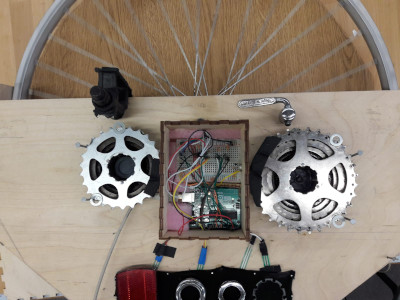This bike wheel sequencer is an interactive electronic DIY instrument designed to generate mechanical sounds patterns that the user can change and control over time.

What it does
This eight-note sample-based music sequencer generates music when the user spins the wheel depending on its speed, which is customizable in real-time.
Two bike cassettes allow to select one sound of the pattern out of eight sounds, and to change it from a few soundbanks. In order to make the change effective, the user has to touch the sprocket. The pedal controls a low pass filter, and a mechanical piece at the right of the central box gives controls over the output volume. Eventually, three other bike scraps (one mirror, and two bolts) trigger sounds related to the bike context: a bowl sound, an electrical sound, a voice saying words related to the bike. The whole craft is hooked up to an arduino that is connected to MaxMSP software, where I designed the music sequencer. Each one of the samples was especially recorded for this project.

Motivation and process
I wanted to give a second life to one common object that everybody knows. Going to London Depford market, I was right away appealed by an old bike wheel. This gave me a lot of design ideas. The final design had to :
- Only use bike related content : mechanical sounds, pieces…
- Be controllable in tempo, pitch, and timbre
- Fun
In order to collect the other scraps, I went to the Bike London Kitchen: A huge thanks to them!
Designing the instrument
The sounds
All sounds were recorded by myself using Shoeps microphones. Here are some examples :
- The sound of my pen against each one of the spokes
- Mechanical sounds on iron tubes
- Electrical sound from an old electric battery…

The craft itself
Here is a list of the different components:
- Two panel mount potentiometers : volume control and filter. They are attached to the break and the mechanical piece on the right.
- One FSR per triggers : mirror and bolts (hidden under the fabric)
- Box to contain the arduino : Made with a lazer cutter
- Reed switch : in order to get the tempo from the speed of the wheel (was inspired by this bike-speedometer instructables webpage).
- Magnetic hall sensors and Magnets : Magnets are attached to the bike cassettes and attract magnets on the inner sides of the box, which create changes in the magnetic field. These changes are detected by the hall sensors on the arduino and used for the sound changes.
MaxMSP
Arduino IDE handles:
- Data collection from the different electronic components
- Scaling of data
- Sending the data to MaxMSP over UDP

- Data received that are sent from the Arduino IDE
- A music sequencer : Created with the sounds that I recorded, and controlled by each on of the controls set on the instruments.
- Presentation mode : User-friendly interface that allows not to see all the code when playing the instrument. Here, only the relevant elements are visible: the tempo, the selection part with the cassettes, and the visibility of the bangs due to the triggers. I also added a “kick” on the first beat of the pattern
Audio & Video Content
Evolutions of the project
The projects was great, but for future works I may work on smaller instruments, that are easier to carry. Maybe working back on the idea but using a small wheel instead of a big one would be better.

